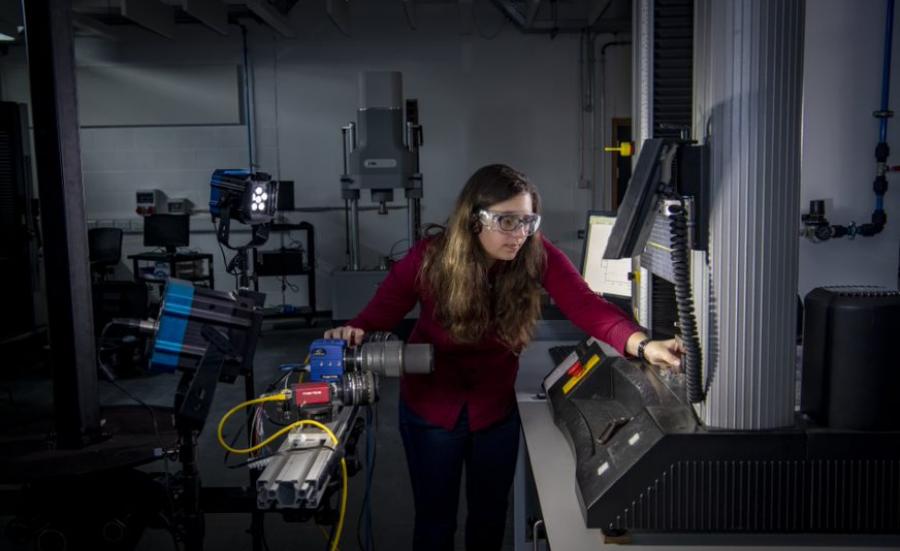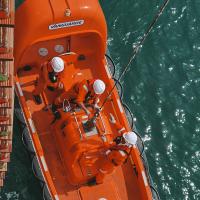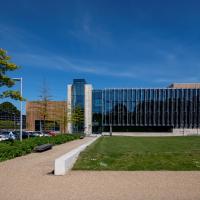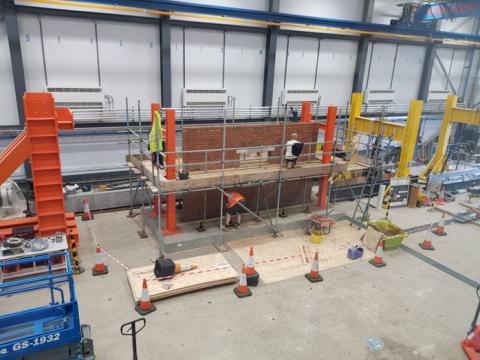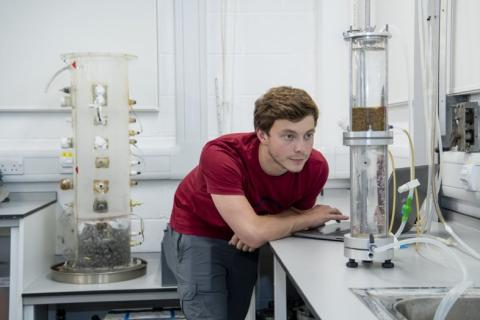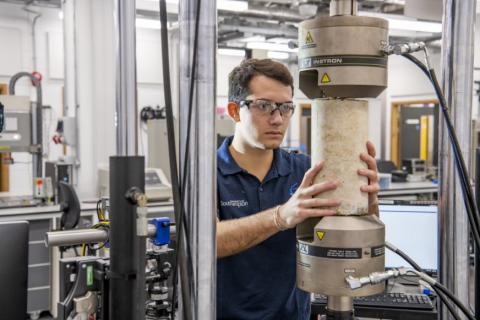Technical specification
Mechanical testing
The TSRL has awide range of static, cyclic and high strain rate machines for testing materials across the loading scales, length scales, temperature scales and strain rates.
Electro-mechanical test machines
For static loading and materials characterisation.
- Suitable for tensile, compressive, shear and bend testing
- Range of capacities: 100N, 500N, 2 kN, 5kN, 50 kN, and 100kN load cells
- Large range of fixtures, grips and loading jigs allowing for different specimen dimensions
- Four machines: Instron 5569, Instron 4204, Instron 3369, Instron 6023
- Bluehill Universal software interface
Electro-dynamic test machines
- Excellent for materials characterisation in static and dynamic loading
- Suitable for tensile, compressive, shear, bend and torsional testing
- Suitable for high cycle and low cycle fatigue testing
- Large range of fixtures, grips, loading jigs
- BNC outputs for synchronisation and recording of test data (load, extension, strain etc)
- Capacity for torsional testing up to 100Nm, axial loading up to 10kN
- 2 machines: Instron Electropuls E1000 and E10000 machines
- Bluehill Universal and Wavematrix 2 software interface
Hydraulic test machines
For static or cyclic testing.
- Excellent for materials characterisation in static and dynamic loading
- Suitable for tensile, compressive, shear, fatigue and bend testing
- Large range of load cell capacities: 5 kN, 10 kN, 40 kN, 100 kN and 630 kN
- Large range of fixtures, grips, loading jigs and machine travel for different specimen dimensions
- BNC outputs for synchronisation and recording of test data (load, extension, strain, etc)
- 6 machines: Instron 8802, 8501, 8502, 8032, DMG200 and Schenck 630
- Bluehill Universal and Wavematrix 2 software interface
High strain rate facilities
- Instron VHS High speed test machine, actuator speed: 0.001 ms-1 up to 20 ms-1
- CEAST 9350 Drop Weight Impact machine, high energy system up to 1800 J
- Inertial Impact Rig (gas gun), impact speeds up to 100 ms-1 and energy of 2.2 kJ
Strain measurement equipment
- Strain gauging and data acquisition equipment (Vishay Strainsmart 8000)
- Large range of extensometry for static and dynamic strain measurement
- Matalect DCM-2 Crack Growth Monitoring system (DCPD)
- digital image correlation systems
Imaging
Imaging techniques
We offer a wide range of non-contacting, non-destructive imaging techniques.
Digital image correlation
This is a non-contact, full-field measurement technique for obtaining in-plane strains on the surface of a specimen in its 2D configuration and out-of-plane deformation in its 3D configuration.
Specimens are prepared with a random speckle pattern, and high-resolution images are captured with one or more white light imaging cameras during deformation.
Applications include:
- measuring surface deformation or strain maps
- strain maps of through thickness strains on bonded joints
- deformation of face sheets of sandwich structure during failure
- strain measurement of composite, metal and foams specimens subjected to high rate loading
High speed imaging
Images are collected at high frame rates and can be used to create a video of an event or to allow measuring. White light imaging can be performed up to 5 million frames per second. Infra-red imaging can be performed up to 100,000 frames per second.
Applications include:
- high strain rate mechanical properties
- characterisation of failure mechanisms
- material characterisation
- dynamic strength of composites
- high speed digital image correlation and imaging methods
Grid method
This can be used for measuring in-plane displacement and strain components on specimens undergoing a small deformation. It's an alternative to digital image correlation, offering superior spatial resolution for roughly the same displacement resolution.
Infrared thermography
Infrared emission from the surface of a material is used to infer its temperature. At ambient temperatures, the peak emission is in the infrared spectrum (~ 1μm to 1 mm wavelengths).
Applications include thermal imaging of processes and detecting damage initiation in structures.
Other thermographic techniques are available for specific applications.
Thermoelastic stress analysis
This provides full-field stress data over the surface of a cyclically loaded component. It's based on the small temperature changes that occur when a material is subject to a change in elastic strain, generally referred to as the ‘thermoelastic effect’.
TSA is a fast, portable and robust way of obtaining stress information from the surface of a specimen or component.
Applications:
- identifying stress distributions in realistic components
- identifying and monitoring fatigue crack propagation
- monitoring damage evolution and damage accumulation in components
- finite element model validation
Pulsed and pulsed-phase thermography
In pulsed thermography, a pulse of heat is applied to the surface of the sample. An infrared detector monitors the surface temperature evolution as the heat front propagates through the material.
If the material below the surface is uniform across the sample, the surface temperature will decay uniformly. If there is a volume of differing thermal properties, such as a subsurface defect, the surface temperature above that defect will vary from the surrounding area.
In pulsed thermography, the infrared thermal data is directly assessed, whereas in pulse phase thermography this data is transformed using a fast Fourier transform to obtain phase values.
These phase values are less affected by surface effects, such as uneven heating, and so allow deeper probing of the material.
Applications include non-destructive evaluation of composite or metallic samples, or of bonded joints for the identification of defects.
Imaging equipment
White light cameras
- 4 x MANTA G504B (5MPx)
- 2 x E-Lite LaVision (5MPx)
- 2 x LaVision Imager LX / X-Lite (26 MPx)
- 2 x FLIR Blackfly S (25MPx)
- High speed white light cameras
- 2 x iX 513 i-speed series (6000 fps full frame up to 1 Million fps)
- 2 x AOS Q-PRI (2000 fps full frame)
- 1 x Shimadzu HPV-X (up to 5 million fps)
- 1 x Photron SA3 (up to 50,000 fps)
- 1 x MotionPro X3plus (up to 50,000 fps)
Infrared imaging systems
- 1 x Telops FAST-M2K (2000 fps full frame up to 100,000 fps)
- 1 x FLIR SC5000 / Cedip Silver 480M
- 1 x FLIR A655sc Microbolometer
- Wide range of lenses
Manufacturing
The composite manufacturing laboratory enables lay-up using pre-preg, hand lay-up and resin infusion techniques. We routinely manufacture samples and components from carbon fibre, glass fibre and natural fibres.
Facilities include:
- work benches for cutting and laminating
- an autoclave and ovens for curing
- a freezer for material storage
